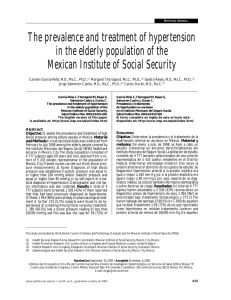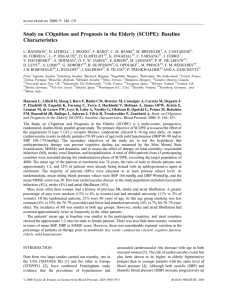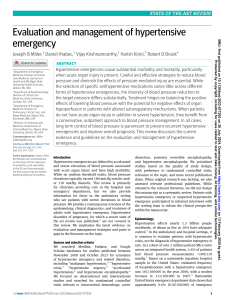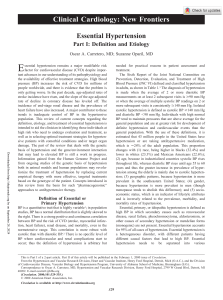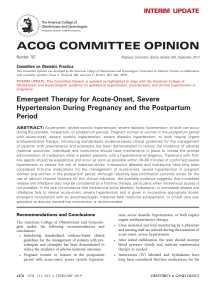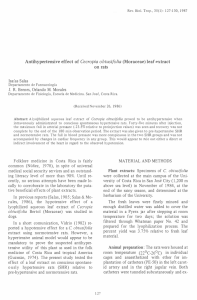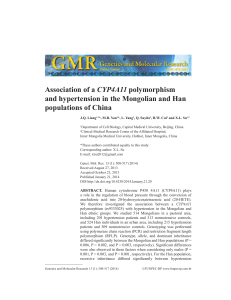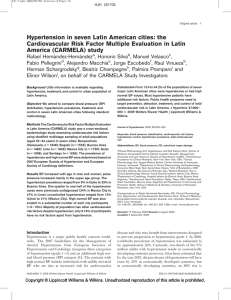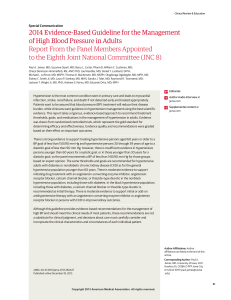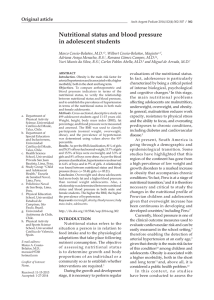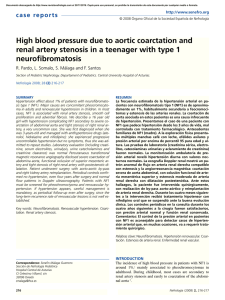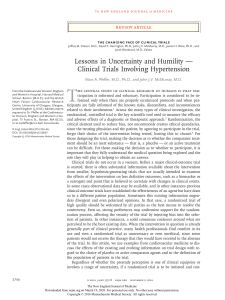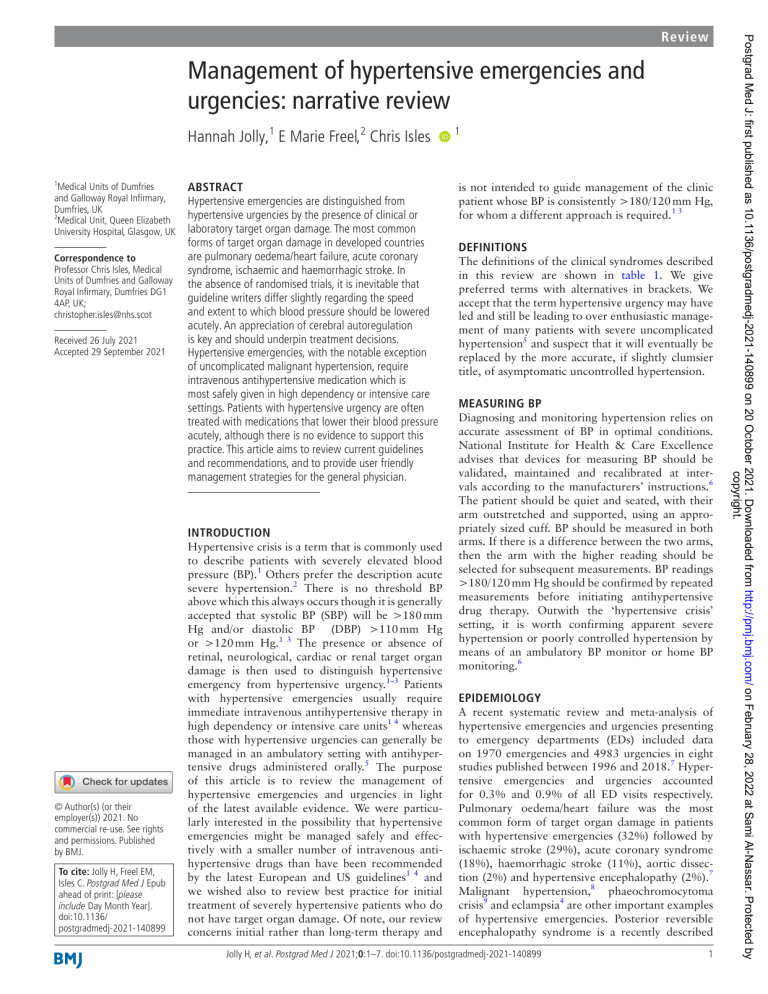
Management of hypertensive emergencies and urgencies: narrative review Hannah Jolly,1 E Marie Freel,2 Chris Isles 1 1 Medical Units of Dumfries and Galloway Royal Infirmary, Dumfries, UK 2 Medical Unit, Queen Elizabeth University Hospital, Glasgow, UK Correspondence to Professor Chris Isles, Medical Units of Dumfries and Galloway Royal Infirmary, Dumfries DG1 4AP, UK; christopher.isles@n hs.scot Received 26 July 2021 Accepted 29 September 2021 ABSTRACT Hypertensive emergencies are distinguished from hypertensive urgencies by the presence of clinical or laboratory target organ damage. The most common forms of target organ damage in developed countries are pulmonary oedema/heart failure, acute coronary syndrome, ischaemic and haemorrhagic stroke. In the absence of randomised trials, it is inevitable that guideline writers differ slightly regarding the speed and extent to which blood pressure should be lowered acutely. An appreciation of cerebral autoregulation is key and should underpin treatment decisions. Hypertensive emergencies, with the notable exception of uncomplicated malignant hypertension, require intravenous antihypertensive medication which is most safely given in high dependency or intensive care settings. Patients with hypertensive urgency are often treated with medications that lower their blood pressure acutely, although there is no evidence to support this practice. This article aims to review current guidelines and recommendations, and to provide user friendly management strategies for the general physician. INTRODUCTION © Author(s) (or their employer(s)) 2021. No commercial re-­use. See rights and permissions. Published by BMJ. To cite: Jolly H, Freel EM, Isles C. Postgrad Med J Epub ahead of print: [please include Day Month Year]. doi:10.1136/ postgradmedj-2021-140899 Hypertensive crisis is a term that is commonly used to describe patients with severely elevated blood pressure (BP).1 Others prefer the description acute severe hypertension.2 There is no threshold BP above which this always occurs though it is generally accepted that systolic BP (SBP) will be >180 mm Hg and/or diastolic BP (DBP) >110 mm Hg or >120 mm Hg.1 3 The presence or absence of retinal, neurological, cardiac or renal target organ damage is then used to distinguish hypertensive emergency from hypertensive urgency.1–3 Patients with hypertensive emergencies usually require immediate intravenous antihypertensive therapy in high dependency or intensive care units1 4 whereas those with hypertensive urgencies can generally be managed in an ambulatory setting with antihypertensive drugs administered orally.5 The purpose of this article is to review the management of hypertensive emergencies and urgencies in light of the latest available evidence. We were particularly interested in the possibility that hypertensive emergencies might be managed safely and effectively with a smaller number of intravenous antihypertensive drugs than have been recommended by the latest European and US guidelines1 4 and we wished also to review best practice for initial treatment of severely hypertensive patients who do not have target organ damage. Of note, our review concerns initial rather than long-­term therapy and is not intended to guide management of the clinic patient whose BP is consistently >180/120 mm Hg, for whom a different approach is required.1 3 DEFINITIONS The definitions of the clinical syndromes described in this review are shown in table 1. We give preferred terms with alternatives in brackets. We accept that the term hypertensive urgency may have led and still be leading to over enthusiastic management of many patients with severe uncomplicated hypertension5 and suspect that it will eventually be replaced by the more accurate, if slightly clumsier title, of asymptomatic uncontrolled hypertension. MEASURING BP Diagnosing and monitoring hypertension relies on accurate assessment of BP in optimal conditions. National Institute for Health & Care Excellence advises that devices for measuring BP should be validated, maintained and recalibrated at intervals according to the manufacturers’ instructions.6 The patient should be quiet and seated, with their arm outstretched and supported, using an appropriately sized cuff. BP should be measured in both arms. If there is a difference between the two arms, then the arm with the higher reading should be selected for subsequent measurements. BP readings >180/120 mm Hg should be confirmed by repeated measurements before initiating antihypertensive drug therapy. Outwith the ‘hypertensive crisis’ setting, it is worth confirming apparent severe hypertension or poorly controlled hypertension by means of an ambulatory BP monitor or home BP monitoring.6 EPIDEMIOLOGY A recent systematic review and meta-­ analysis of hypertensive emergencies and urgencies presenting to emergency departments (EDs) included data on 1970 emergencies and 4983 urgencies in eight studies published between 1996 and 2018.7 Hypertensive emergencies and urgencies accounted for 0.3% and 0.9% of all ED visits respectively. Pulmonary oedema/heart failure was the most common form of target organ damage in patients with hypertensive emergencies (32%) followed by ischaemic stroke (29%), acute coronary syndrome (18%), haemorrhagic stroke (11%), aortic dissection (2%) and hypertensive encephalopathy (2%).7 Malignant hypertension,8 phaeochromocytoma crisis9 and eclampsia4 are other important examples of hypertensive emergencies. Posterior reversible encephalopathy syndrome is a recently described Jolly H, et al. Postgrad Med J 2021;0:1–7. doi:10.1136/postgradmedj-2021-140899 1 Postgrad Med J: first published as 10.1136/postgradmedj-2021-140899 on 20 October 2021. Downloaded from http://pmj.bmj.com/ on February 28, 2022 at Sami Al-Nassar. Protected by copyright. Review Table 1 Definitions Hypertensive crisis (acute severe hypertension) Omnibus terms that include patients with both hypertensive emergencies and hypertensive urgencies Hypertensive emergency Severe hypertension with target organ damage Hypertensive urgency (asymptomatic uncontrolled hypertension) Severe hypertension without target organ damage Malignant hypertension (accelerated hypertension) Severe hypertension with bilateral retinal haemorrhages and exudate and/or bilateral papilloedema neurological disorder, similar to but distinct from hypertensive encephalopathy, characterised by visual disturbances, headache, vomiting, seizures and altered consciousness. It is usually associated with severe hypertension which, when present, should be treated as a hypertensive emergency.10 MALIGNANT HYPERTENSION Malignant hypertension is a hypertensive emergency that occurs when a sudden and marked increase in BP triggers a form of thrombotic microangiopathy characterised clinically by severe retinopathy and histologically by fibrinoid arteriolar necrosis.4 It was first described in 1928 and its association then with a high likelihood of death within a year from stroke, heart failure or kidney failure resulted in its name.11 Keith and colleagues12 subsequently distinguished severely hypertensive patients with bilateral papilloedema (grade 4 hypertensive retinopathy) from those with bilateral flame-­ shaped haemorrhages and cotton wool spots (grade 3 hypertensive retinopathy) and used the term accelerated hypertension to describe this latter group. Clinical outcomes in an era of effective antihypertensive treatment have since been shown to be the same in both groups of patients and because of this we tend to use the terms interchangeably.13 Malignant hypertension can arise in patients with essential hypertension or complicate renovascular and parenchymal renal disease, and can in turn be complicated by any one of a number of organ failures including hypertensive encephalopathy (seizures, lethargy, cortical blindness and coma), hypertensive heart failure and hypertensive renal failure.4 Many of these patients will have evidence of secondary hyperaldosteronism (hypokalemia with elevated plasma renin and serum aldosterone) and a microangiopathic haemolytic anaemia (thrombocytopenia with red cell fragments on blood film).4 Figure 1 Cerebral autoregulatory curve showing the relation between cerebral blood flow and mean arterial pressure. This is shifted to the right in patients with chronic hypertension. Cerebral blood flow becomes pressure dependent for a time after acute stroke. Reproduced with permission from Manning et al.16 HOW QUICKLY SHOULD BP BE LOWERED IN HYPERTENSIVE EMERGENCY? To our knowledge there are no large randomised trials comparing different rates of BP reduction for patients presenting with a hypertensive emergency except in acute stroke.14 15 In the absence of such studies, management strategies are guided by expert opinion and by our understanding of cerebral autoregulation, the phenomenon by which cerebral blood flow remains constant across a wide range of mean arterial pressures from around 50–150 mm Hg16 (figure 1). The autoregulatory curve is reset upwards in patients who have been hypertensive for some time, which exposes them to the risk of cerebral hypoperfusion if BP is lowered too quickly.16 Although less well studied, it is likely that cardiac and renal blood flow are subject to similar autoregulatory control. Myocardial infarction and stroke have both been reported following over rapid reduction in BP, with sublingual nifedipine identified as particularly hazardous in this setting.5 In the absence of randomised trials, it is inevitable that the guideline writers differ slightly in their advice. Given the likelihood that cardiac and renal blood flow undergo similar autoregulatory control as cerebral perfusion, it is intuitive that, under most circumstances, BP should be lowered slowly and cautiously. Accordingly, the European Society of Cardiology (ESC) Position Document on the Management of Hypertensive Emergencies in 20194 and the American Heart Association (AHA) Guideline on the Management of High Blood Pressure in Adults in 20181 advise that BP be decreased by not >25% during the first hour for patients with malignant hypertension with or without acute kidney injury; then to 160/100–110 mm Hg during the following 2–6 hours; and then cautiously to normal during the following 24–48 hours1 4 (table 2). For patients with ‘compelling’ reasons for more rapid control of BP, namely those with aortic dissection, hypertensive heart failure, acute coronary syndrome, phaeochromocytoma crisis or eclampsia, the guidelines recommend that SBP be lowered to <140 mm Hg during the first hour and to <120 mm Hg in aortic dissection.1 4 Randomised trials in acute stroke permit a slightly more evidence-­based approach. A major concern here is that if the BP is lowered too far or too quickly there may be an increased risk of cerebral hypoperfusion and worsened stroke outcome. Both the ESC and AHA offer broadly similar advice, namely that careful acute BP lowering with intravenous therapy should be considered in patients with acute intracerebral haemorrhage whose SBP is >220 mm Hg, avoiding SBP <140 mm Hg1.4 A more cautious approach is recommended for acute ischaemic stroke because autoregulation fails and cerebral blood flow becomes pressure dependent in the area of infarction.16 Here, both the ESC and AHA advise that patients should have their BP lowered to <185/110 mm Hg before thrombolysis; and that in patients with markedly elevated BP who are not thrombolysed, drug therapy may be considered, based on clinical judgement, to reduce BP by 15% during the first 24 hours after the stroke event1 4 (table 2, figure 2). The management strategies in this table are from the latest European4 and US1 guidelines, also from a 2019 review of hypertensive crises.2 2 Jolly H, et al. Postgrad Med J 2021;0:1–7. doi:10.1136/postgradmedj-2021-140899 CEREBRAL AUTOREGULATION Postgrad Med J: first published as 10.1136/postgradmedj-2021-140899 on 20 October 2021. Downloaded from http://pmj.bmj.com/ on February 28, 2022 at Sami Al-Nassar. Protected by copyright. Review Table 2 Treatment strategies for hypertensive emergencies Clinical presentation Reduce Preferred intravenous drugs Malignant hypertension Reduce MAP by not >20%–25% during the first hour and then aim for 160/100–110 mm Hg during the following 2–6 hours. Labetalol or nicardipine (but consider oral therapy if uncomplicated malignant hyprtension Hypertensive encephalopathy Reduce MAP by not >20%–25% during the first hour and then aim for 160/100–110 mm Hg during the following 2–6 hours. Labetalol or nicardipine Acute haemorrhagic stroke If SBP >220 mm Hg, recommend lowering to SBP 140–179 mm Hg; if SBP 180–220 mm Hg, consider lowering to SBP 140–179 mm Hg. Lowering systolic BP <140 mm Hg may be harmful. Labetalol or nicardipine Acute ischaemic stroke Thrombolysis indicated: target BP <185/110 prior to thrombolysis, Labetalol or nicardipine maintain <180/105 for 24 hours. Thrombolysis not indicated and BP ≥220/120 or target organ damage: lower BP by 15% in 1 hour. Thrombolysis not indicated and no target organ damage other than stroke and BP <220/120: no intervention for 48–72 hours. Acute coronary syndrome Aim to reduce SBP to <140 mm Hg during the first hour while keeping DBP >60 mm Hg Nitroglycerin or labetalol Acute cardiogenic pulmonary oedema Aim to reduce SBP to <140 mm Hg during the first hour Nitroglycerin with loop diuretic Aortic dissection Aim to reduce SBP to <120 mm Hg and heart rate to <60 beats/min during the Labetalol or esmolol with nicardipine or nitroglycerine first hour Phaeochromocytoma crisis Aim to reduce SBP to <140 mm Hg during the first hour Phentolamine Eclampsia Aim to reduce SBP to <160 mm Hg and DBP to <105 mm Hg during the first hour Labetalol and magnesium sulphate or nicardipine and magnesium sulphate BP, blood pressure; DBP, diastolic blood pressure; MAP, mean arterial pressure; SBP, systolic blood pressure. WHICH DRUG FOR HYPERTENSIVE EMERGENCIES? The ESC and the AHA provide dosing schedules for 12 intravenous antihypertensive drug choices, namely labetalol, nitroglycerin, nicardipine, esmolol, nitroprusside, fenoldapam, clevidipine, enalaprilat, urapidil, clonidine, hydralazine and phentolamine.1 4 It is unlikely that clinicians will have experience of more than a few of these, given that hypertensive emergencies are uncommon and the indications for their intravenous use infrequent. It is our belief that it is better for clinicians to familiarise themselves with a smaller number of treatment options and that all the hypertensive emergencies listed in table 2 except for phaeochromocytoma crisis can be managed safely and effectively with just three of these drugs, namely labetalol, nitroglycerin and nicardipine. We include nicardipine here because it is recommended as a first-­line treatment for hypertensive encephalopathy, hypertension associated with acute stroke, aortic dissection and eclampsia1 4 even though it is not available in all UK hospitals, as judged by a survey we conducted of hospital pharmacists in 25 Scottish district and regional hospitals showing availability of the intravenous antihypertensives recommended by European and US guideline writers (figure 3). There may be an occasional requirement for esmolol, an ultrashort acting beta blocker in the management of acute aortic dissection.1 4 Hydralazine has both an unpredictable BP response and often a prolonged duration of action which makes it an undesirable choice in most patients.1 Nitroprusside, fenoldapam, clevidipine, enalaprilat, urapidil and clonidine do not appear to offer clear advantages and are not all stocked routinely in all UK hospitals (figure 3). Magnesium sulphate is recommended as an adjunct to intravenous antihypertensive therapy in eclampsia, primarily to prevent seizures. The intravenous drug doses, onset, duration of action and contraindications for the antihypertensive drugs shown in table 2 are given in table 3. Figure 2 Management of severe hypertension in acute ischaemic stroke (left panel), and acute haemorraghic stroke (right panel) adapted from Whelton et al1 and van den Born et al.4 BP, blood pressure; DBP, diastolic blood pressure; HT, hypertensive; SBP, systolic blood pressure. Jolly H, et al. Postgrad Med J 2021;0:1–7. doi:10.1136/postgradmedj-2021-140899 3 Postgrad Med J: first published as 10.1136/postgradmedj-2021-140899 on 20 October 2021. Downloaded from http://pmj.bmj.com/ on February 28, 2022 at Sami Al-Nassar. Protected by copyright. Review have same day specialist review, though it may be possible to manage them safely in an ambulatory setting.6 PHAEOCHROMOCYTOMA CRISIS Figure 3 Survey of hospital pharmacists in 25 Scottish district and regional hospitals showing availability of the intravenous antihypertensives recommended by European and US guideline writers. TREATMENT OF UNCOMPLICATED MALIGNANT HYPERTENSION A possible exception to the general rule that all hypertensive emergencies require intravenous antihypertensive medication is severe hypertension with bilateral retinal changes as described above but with no evidence of neurological, cardiac or renal target organ damage. In the absence of these complications, intravenous antihypertensive therapy may be unnecessary and potentially harmful.5 In a small randomised trial of 20 patients with malignant hypertension a single dose of a slow release preparation of nifedipine caused BP to fall from 233/142 mm Hg to 166/100 mm Hg (28% reduction in systolic) at 5 hours while a single dose of atenolol 100 mg reduced BP from 226/141 mm Hg to 162/100 mm Hg (28% reduction in systolic) at 16 hours. There were no precipitous falls in pressure, no patient developed focal neurological signs, nor was heart failure precipitated by either form of treatment.17 Slow release nifedipine and atenolol are used much less widely than before, though alternative dihydropyridines such as amlodipine or betablockers such as bisoprolol are likely to be as effective. These patients should Table 3 Phaeochromocytoma may occasionally present as a hypertensive emergency, although this is more often seen during the perioperative period due to tumour handling/anaesthetic agents. This can be minimised by use of alpha blockers for at least 14 days prior to surgery and by titrating the dose in order to achieve a normal target BP. A postural drop in BP is further evidence of adequate alpha blockade in this setting. A review of five follow-­ u p studies comparing phenoxybenzamine (non-­selective) and doxazosin (selective) alpha blockade found that systolic pressure was slightly better controlled with phenoxybenzamine, although with more pronounced post operative hypotension and side effects, namely postural hypotension, oedema and nasal stuffiness. 18 Phenoxybenzamine often had to be prescribed with a beta blocker to control reflex tachycardia while patients taking doxazosin received significantly more additional antihypertensive medication including calcium channel blockers and ACE inhibitors. 18 Beta blockers, when given, should only be prescribed after establishing adequate alpha blockade to prevent unopposed alpha vasoconstriction. 4 Phaeochromocytoma crisis, when it occurs, is usually treated with intravenous phentolamine, a short acting non-­ s elective alpha blocker. The recommended dose for intravenous use is 5 mg by bolus injection with additional bolus doses every 10 min as required to lower BP to target. Labetalol, which has more beta than alpha blocking activity, may be associated with a hypertensive response in phaeochromocytoma especially if alpha blockade is insufficient and should not be used as the initial therapy.9 HYPERTENSIVE URGENCIES The absence of target organ damage in patients with SBP >180 mm Hg and/or DBP >110 mm Hg or <120 mm Hg 13 defines a hypertensive urgency which is usually managed by antihypertensive drugs given orally with the aim Intravenous antihypertensive drugs for hypertensive emergencies Drug Mode of action Onset and duration Usual dose range Contraindications Labetolol Combined non-­selective beta-­ Onset 5–10 min blocker and alpha-­1 blocker Duration 3–6 hours (intravenous beta-­to-­alpha blocking ration 7:1) 10–20 mg intravenous bolus every 10 min or 2–4 mg/min Systolic heart failure intravenous infusion until goal BP achieved, thereafter second or third degree atrio-­ 5–20 mg/hour, up to maximum 300 mg if required ventricularblock Asthma Badycardia Phaeochromocytoma (insufficient alpha blockade) Nitroglycerin Mixed venous and arteriolar dilator Onset 3–5 min with predominant venous effects Duration 3–5 min Initially 5 μg/min increasing by 5 μg/min every 3–5 min to Avoid if volume deplete a maximum of 200 μg/min Tolerance can limit usefulness Nicardipine Vasodilating dihydropyridine calcium channel blocker Onset 5–15 min Duration 1–4 hours 5 mg/hour intravenous for 15 min increasing by 2.5 mg/ hour every 5–15 min to max 15 mg/hour. Reduce gradually when target BP achieved, usual maintenance 2–4 mg/hour. Severe aortic stenosis Acute coronary syndrome (because of reflex tachycardia) Esmolol Ultra short acting cardio selective betablocker used sometimes in aortic dissection Onset 1–2 min Duration 10–30 min Initially 0.5-­1 μg/kg/min over 1 min followed by 50 μg/kg/min infusion. Max infusion rate 200 μg/kg/min Systolic heart failure second or third degree AV block Asthma Bradycardia Phentolamine Non selective alpha blocker for use in phaeochromocytoma hypertensive crisis Onset 1–2 min Duration 10–30 min Initially 5 mg intravenous bolus with additional bolus doses every 10 min as required to lower BP to target No contraindications though adverse effects include tachycardias and chest pain. BP, blood pressure. 4 Jolly H, et al. Postgrad Med J 2021;0:1–7. doi:10.1136/postgradmedj-2021-140899 Postgrad Med J: first published as 10.1136/postgradmedj-2021-140899 on 20 October 2021. Downloaded from http://pmj.bmj.com/ on February 28, 2022 at Sami Al-Nassar. Protected by copyright. Review of achieving normotension over a period of days. 5 Hypertensive urgencies are essentially a diagnosis of exclusion in patients with very elevated BPs who are otherwise well. They may have headaches and non-­specific symptoms 7 but they do not, by definition, have clinical or laboratory evidence of target organ damage. Many will have stopped taking their antihypertensive therapy and simply require this to be restarted. 19 Breu and Axon5 then recommend that treatable causes of hypertension should be assessed. In hospitalised patients, these include missed or withheld doses of outpatient medications, pain, nausea, alcohol and/or benzodiazepine withdrawal, delirium and obstructive sleep apnoea. If no immediately treatable cause can be found then patients should be allowed to rest for 30 min before initiating or resuming antihypertensive medication. Grassi and colleagues20 have shown in a study of 574 patients presenting to ED with BP >180/110 mm Hg that 31% responded with a fall in SBP >20 mmHg and/or a fall in DBP >10 mmHg during 30 min of rest before receiving antihypertensive drug therapy. Those whose BP remained >180/110 mm Hg despite resting were randomly assigned to a single oral dose of amlodipine 5 mg, perindopril 4 mg or labetalol 200 mg. A favourable BP response (>20/10 mmHg as above) 2 hours after drug administration was recorded in 71%, 76% and 84% of amlodipine, perindopril and labetalol patients, respectively (p=NS).20 These findings suggest it does not matter greatly whether a calcium channel blocker, ACE inhibitor or beta blocker is given. Patients can usually be discharged after a brief period of observation. These patients then require careful follow-­u p either in secondary care or in the community. A study by Patel and colleagues21 found no difference in outcomes at 6 months if patients with SBP ≥180 mm Hg and/or DBP ≥110 mm Hg but no target organ damage were treated in the community rather than referred to hospital, reinforcing the view that such patients can and should be managed in an ambulatory setting. It has recently been suggested that the term ‘hypertensive urgency’ may no longer be useful and possibly even harmful, as aggressive dosing with oral agents that rapidly lower BP is not without risk. 5 Because there is no evidence that treatment of hypertensive patients without target organ damage should be any different from those with asymptomatic uncontrolled hypertension, a ESC position paper considers that it may be preferable to abandon the term ‘hypertensive urgency’ and only use hypertensive emergency to refer to those situations where immediate treatment is required.4 Investigation of hypertension for a secondary cause generally reveals a small number of patients with treatable disorders, of whom only a few will be cured by specific intervention, and a moderate number with irreversible disease who are at high risk of myocardial infarction and stroke. 22 The more severe the hypertension the more likely it is that an underlying cause will be identified. 23 Secondary causes of hypertension, which are found in only 8% patients with non-­m alignant hypertension attending a BP clinic, 22 may be present in up to 40% patients with malignant hypertension. 8 24 Most will be due to an underlying renal abnormality. 8 24 The prevalence of secondary hypertension among hypertensive emergencies other than malignant hypertension has been less studied, although screening for an underlying cause is likely to be appropriate in most cases given the severity of the hypertension. 25 Screening for the conditions described below will generally take place after antihypertensive treatment has been started. Routine investigations including haemoglobin, urea and electrolytes (U&E), urinalysis and ECG, together with examination of the fundi for the presence of hypertensive retinopathy, are all that are required before initiating therapy in patients who present to the ED, primary care or outpatient clinic with severe hypertension. Renal vascular, renal parenchymal and endocrine causes should be considered. U&E, urine dip for blood and protein, spot urine for albumin or protein creatinine ratio and renal ultrasound will identify most cases of underlying renal disease. The presence of kidney injury can occur with the malignant phase of essential hypertension, bilateral renovascular disease and glomerulonephritis including renal vasculitis. Renovascular disease may be due to fibromuscular dysplasia, especially in younger women, but is more commonly atherosclerotic affecting the main renal arteries. Inequality of renal size on ultrasound suggests a renovascular cause and should lead to further investigation by CT renal angiography or MR angiography, whereas significant proteinuria and/or haematuria points to glomerular disease, which can be confirmed by renal biopsy.25 The three most important endocrine causes of hypertension are phaeochromocytoma, Cushing’s syndrome and primary aldosteronism (PA). Phaeochromocytoma is a rare cause of hypertension. It usually presents with paroxysmal or sustained hypertension and headache, less commonly with the ‘classic triad’ of episodic headache, palpitations and sweating. The diagnosis is confirmed or excluded by measurement of urinary or plasma metanephrines. The clues to cortisol excess in Cushing’s syndrome are hypertension with central obesity, livid striae, easy bruising and proximal myopathy. Cortisol excess can be excluded by suppression of early morning plasma cortisol after an overnight (1 mg) or low dose (4 mg over 2 days) dexamethasone suppression test. Appropriate alternative screening tests include midnight salivary cortisol or 24 hours urinary free cortisol. PA is now considered the most common cause of secondary hypertension (approximately 10% of cases) although hypokalaemia, the biochemical clue to diagnosis, is only found in up to 50% of cases. Screening for PA begins with assessment of plasma renin and aldosterone concentrations: classically plasma renin is low (and often undetectable) and plasma aldosterone is inappropriately normal or high. Both Cushing’s syndrome and PA are more commonly associated with resistant hypertension than with hypertensive emergency or urgency.23 Obstructive sleep apnoea is a common cause of hypertension and a recently recognised cause of hypertensive crisis, but is more commonly associated with hypertensive urgency than emergency. 26 Medications and chemical substances remain an under-­ a ppreciated cause of secondary hypertension. The list of drugs that can cause hypertension is extensive and includes glucocorticoids, mineralocorticoids, non-­s teroidal anti-­inflammatory drugs, some antidepressant drugs, cyclosporine, recombinant human erythropoietin and many recreational drugs. 27 Drug-­induced BP increases are usually small and transient though both hypertensive urgency and emergency have been reported with cocaine and amphetamines including methylated amphetamines (ecstasy) in particular.27 Jolly H, et al. Postgrad Med J 2021;0:1–7. doi:10.1136/postgradmedj-2021-140899 5 SECONDARY CAUSES OF HYPERTENSION Postgrad Med J: first published as 10.1136/postgradmedj-2021-140899 on 20 October 2021. Downloaded from http://pmj.bmj.com/ on February 28, 2022 at Sami Al-Nassar. Protected by copyright. Review Research questions Self-­assessment questions ►► Observation for longer periods before starting drug therapy 1. Which of the following are present or can occur in malignant hypertension? a. Bilateral retinal haemorrhages and exudates b. Microangiopathic haemolytic anaemia c. Secondary hyperaldosteronism d. Hypertensive heart failure e. Kidney injury 2. A patient is found by his general practitioner to have BP 220/116 mm Hg. Which of the following investigations should form part of his initial assessment? a. ECG b. U&E c. Aldosterone renin ratio d. Urine PCR e. Urine catecholamines 3. A patient with paroxysmal hypertension is found to have raised urinary catecholamines. Which of the following would you consider as first-­line treatment for her hypertension? a. Bisoprolol b. Amlodipine c. Doxazosin d. Ramipril e. Phenoxybenzamine 4. Intravenous labetalol would be an appropriate choice as initial treatment for which of the following hypertensive emergencies? a. Hypertensive encephalopathy b. Uncomplicated malignant hypertension c. Phaeochromocytoma crisis d. Aortic dissection e. Haemorrhagic stroke with severe hypertension 5. Blood pressure during the first hour of treatment in malignant hypertension should be lowered by not more than a. 10% b. 20% c. 25% d. 30% e. 40% in patients presenting to the Emergency Department with SBP greater than 180mmHg and no evidence of target organ damage. ►► Randomised trial of oral bisoprolol, ramipril and amlodipine for patients with no target organ damage whose SBP remains greater than 180mmHg despite at least 5 BP readings and at least 60 minutes observation. ►► Randomised trial of oral bisoprolol, ramipril and amlodipine as initial management of patients with uncomplicated malignant hypertension. Main messages ►► Hypertensive emergencies are distinguished from hypertensive urgencies by the presence of clinical or laboratory target organ damage. ►► The most common forms of target organ damage in developed countries are pulmonary oedema/heart failure, acute coronary syndrome, ischaemic and haemorrhagic stroke. ►► Hypertensive emergencies, with the notable exception of uncomplicated malignant hypertension, require intravenous antihypertensive medication which is most safely given in a high dependency or intensive care setting. ►► It is our belief that hypertensive emergencies, except for phaeochromocytoma crisis, can be managed safely and effectively with one of intravenous labetalol, nitroglycerin or nicardipine. ►► Patients with hypertensive urgency are often treated with medications that lower their blood pressure acutely, although there is no evidence to support this practice. Key references 1. Whelton PK, Carey RM, Aronow WS, et al. 2017 ACC/AHA/ AAPA/ABC/ACPM/AGS/ APhA/ASH/ASPC/NMA/PCNA guideline for the prevention, detection, evaluation, and management of high blood pressure in adults: a report of the American College of Cardiology/American Heart Association Task Force on Clinical Practice Guidelines. Hypertension 2018;71:1269–324. 2. Peixoto AJ. Acute severe hypertension. N Engl J Med 2019;381:1843–5. 3. Williams B, Mancia G, Spiering W, et al. 2018 Practice Guidelines for the management of arterial hypertension of the European Society of Hypertension and the European Society of Cardiology: ESH/ESC Task Force for the Management of Arterial Hypertension. Eur Heart J 2018; 39; 3021–104. 4. Van den Born BH, Lip GYH, Brguljan-­Hitij J, et al. ESC Council on hypertension position document on the management of hypertensive emergencies. Eur Heart J Cardiovasc Pharmacother 2019;5:37–46. 5. Breu AC, Axon RN. Acute treatment of hypertensive urgency. J Hosp Med 2018;13:860–62. 6 Contributors CI had the idea and wrote the first draft; HJ conducted the survey of Scottish hospitals; all three authors contributed to and approved the final version. The corresponding author attests that all listed authors meet authorship criteria and that no others meeting the criteria have been omitted. Funding The authors have not declared a specific grant for this research from any funding agency in the public, commercial or not-­for-­profit sectors. Competing interests None declared. Patient consent for publication Not applicable. Provenance and peer review Not commissioned; externally peer reviewed. ORCID iD Chris Isles http://orcid.org/0000-0001-7830-7561 REFERENCES 1 Whelton PK, Carey RM, Aronow WS, et al. 2017 ACC/AHA/AAPA/ABC/ACPM/AGS/ APhA/ASH/ASPC/NMA/PCNA guideline for the prevention, detection, evaluation, and management of high blood pressure in adults: Executive summary: a report of the American College of Cardiology/American heart association Task force on clinical practice guidelines. Hypertension 2018;71:1269–324. 2 Peixoto AJ. Acute severe hypertension. N Engl J Med 2019;381:1843–52. 3 Williams B, Mancia G, Spiering W. 2018 practice guidelines for the management of arterial hypertension of the European Society of hypertension and the European Society of cardiology: ESH/ESC Task force for the management of arterial hypertension. Eur Heart J 2018:3021–104. Jolly H, et al. Postgrad Med J 2021;0:1–7. doi:10.1136/postgradmedj-2021-140899 Postgrad Med J: first published as 10.1136/postgradmedj-2021-140899 on 20 October 2021. Downloaded from http://pmj.bmj.com/ on February 28, 2022 at Sami Al-Nassar. Protected by copyright. Review 4 van den Born B-­JH, Lip GYH, Brguljan-­Hitij J, et al. ESC Council on hypertension position document on the management of hypertensive emergencies. Eur Heart J Cardiovasc Pharmacother 2019;5:37–46. 5 Breu AC, Axon RN. Acute treatment of hypertensive urgency. J Hosp Med 2018;13:860–2. 6 NICE guideline 136. Hypertension in adults: diagnosis and management, 2019. Available: www.nice.org.uk/guidance/ng136 7 Astarita A, Covella M, Vallelonga F, et al. Hypertensive emergencies and urgencies in emergency departments: a systematic review and meta-­analysis. J Hypertens 2020;38:1203–10. 8 van den Born B-­JH, Koopmans RP, Groeneveld JO, et al. Ethnic disparities in the incidence, presentation and complications of malignant hypertension. J Hypertens 2006;24:2299–304. 9 Whitelaw BC, Prague JK, Mustafa OG, et al. Phaeochromocytoma crisis. Clin Endocrinol 2014;80:13–22. 10 Parasher A, Jhamb R. Posterior reversible encephalopathy syndrome (PRES): presentation, diagnosis and treatment. Postgrad Med J 2020;96:623–8. 11 Keith NM, Wagener HP, Kernohan JW. The syndrome of malignant hypertension. Arch Intern Med 1928;41:141–88. 12 Keith NM, Wagener HP, Barker NW. Some different types of essential hypertension: their course and prognosis. Am J Med Sci 1939;197:332–43. 13 McGregor E, Isles CG, Jay JL, et al. Retinal changes in malignant hypertension. Br Med J 1986;292:233–4. 14 Zhao R, Liu F-­D, Wang S, et al. Blood pressure reduction in the acute phase of an ischemic stroke does not improve short- or long-­term dependency or mortality: a meta-­analysis of current literature. Medicine 2015;94:e896. 15 Qureshi AI, Palesch YY, Barsan WG, et al. Intensive blood-­pressure lowering in patients with acute cerebral hemorrhage. N Engl J Med 2016;375:1033–43. 16 Manning L, Robinson TG, Anderson CS. Control of blood pressure in hypertensive neurological emergencies. Curr Hypertens Rep 2014;16:436. 17 Isles CG, Johnson AO, Milne FJ. Slow release nifedipine and atenolol as initial treatment in blacks with malignant hypertension. Br J Clin Pharmacol 1986;21:377–83. 18 Van der Zee PA, de Boer A. Pheochromocytoma: a review on preoperative treatment with phenoxybenzamine or doxazosin. Netherland Med J 2014;72:190–201. 19 Hameed MA, Tebbit L, Jacques N, et al. Non-­adherence to antihypertensive medication is very common among resistant hypertensives: results of a directly observed therapy clinic. J Hum Hypertens 2016;30:83–9. 20 Grassi D, O’Flaherty M, Pellizzari M, et al. Hypertensive Urgencies in the emergency department: evaluating blood pressure response to rest and to antihypertensive drugs with different profiles. J Clin Hypertens 2008;10:662–7. 21 Patel KK, Young L, Howell EH, et al. Characteristics and outcomes of patients presenting with hypertensive urgency in the office setting. JAMA Intern Med 2016;176:981. 22 Sinclair AM, Isles CG, Brown I, et al. Secondary hypertension in a blood pressure clinic. Arch Intern Med 1987;147:1289–93. 23 Acelajado MC, Calhoun DA. Aldosteronism and resistant hypertension. Int J Hypertens 2011;2011:837817. 24 Lip GY, Beevers M, Beevers G. The failure of malignant hypertension to decline: a survey of 24 years’ experience in a multiracial population in England. J Hypertens 1994;12:1297–305. 25 Mancia G, Fagard R, Narkiewicz K. 2013 ESH/ESC guidelines for the management of arterial hypertension. Eur Heart J 2013;34:2159–219. 26 Khamsai S, Chootrakool A, Limpawattana P, et al. Hypertensive crisis in patients with obstructive sleep apnea-­induced hypertension. BMC Cardiovasc Disord 2021;21:310. 27 Grossman E, Messerli FH. Drug-­Induced hypertension: an unappreciated cause of secondary hypertension. Am J Med 2012;125:14–22. Jolly H, et al. Postgrad Med J 2021;0:1–7. doi:10.1136/postgradmedj-2021-140899 7 Answers 1. 2. 3. 4. 5. True, true, true, true, true. True, true, false, true, false. False, false, true, false, true. True, false, false, true, true. False, false, true, false, false. Postgrad Med J: first published as 10.1136/postgradmedj-2021-140899 on 20 October 2021. Downloaded from http://pmj.bmj.com/ on February 28, 2022 at Sami Al-Nassar. Protected by copyright. Review
